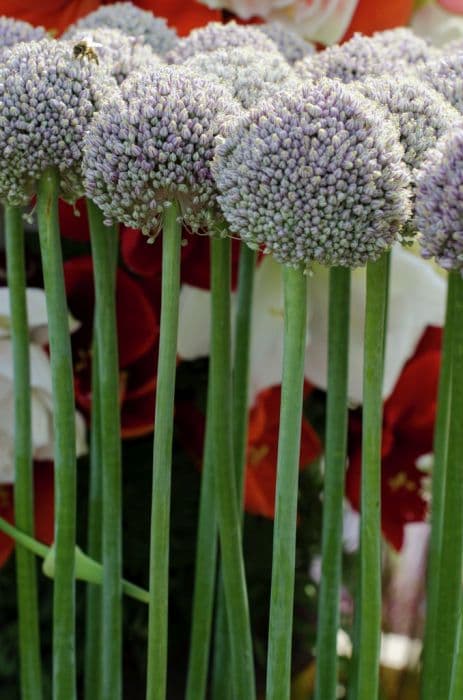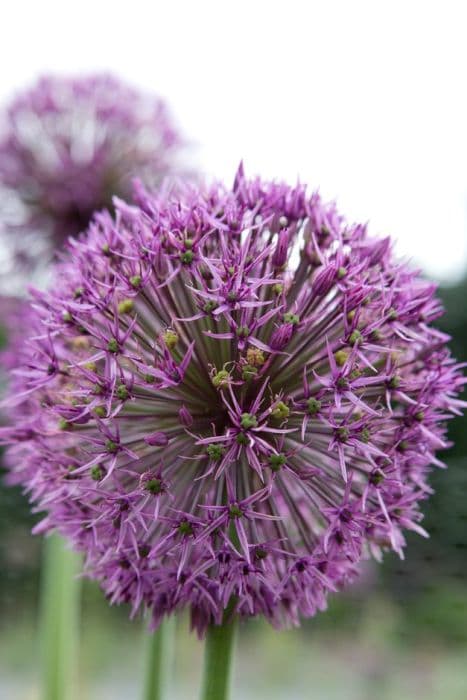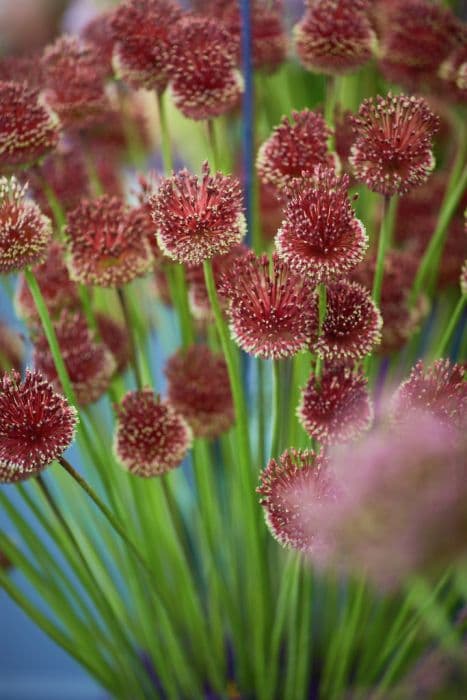Yellow onion Allium flavum











ABOUT
Allium flavum, commonly known as the small yellow onion, is a bulbous perennial with a distinctive appearance. This plant typically produces a basal rosette of narrow, strap-shaped leaves that are a glossy green color. The foliage tends to be quite lush, providing an attractive low-growing clump. The most striking feature of the small yellow onion is its flowering stalk. From the center of the foliage, a leafless stem emerges, which culminates in an umbrella-like cluster of star-shaped flowers. The blossoms have a cheerful yellow hue, presenting a showy display that can add a bright spot to the garden when they are in bloom. Each individual flower is petite and has six pointed tepals that flare outward, giving the blooms a delicate and airy appearance. The tepals often exhibit a slight curl at their tips, adding to the ornamental quality of the umbel. In the center of the flowers are stamens that may protrude or be just barely visible, depending on the particular variety. These flowers usually attract bees, butterflies, and other pollinators, adding to the dynamic scene in the garden. After flowering, the plant may produce capsule-like fruit, but it is the flowers that are the main attraction. The overall look of the small yellow onion is charming and naturalistic, making it a beloved choice for rock gardens, borders, and cottage-style plantings.
About this plant
 Names
NamesFamily
Amaryllidaceae
Synonyms
Small Yellow Allium, Yellow Allium, Ornamental Onion
Common names
Allium flavum subsp. tauricum, Allium tauricum, Allium paniculatum var. flavum.
 Characteristics
CharacteristicsLife cycle
Perennials
Foliage type
Deciduous
Color of leaves
Green
Flower color
Yellow
Height
1 foot (30 centimeters)
Spread
0.5 foot (15 centimeters)
Plant type
Bulb
Hardiness zones
5
Native area
Mediterranean
Benefits
 General Benefits
General Benefits- Ornamental Value: Allium flavum, commonly known as small yellow onion, has an aesthetic appeal with its small, bell-shaped yellow flowers that can enhance the beauty of gardens and landscapes.
- Culinary Uses: The plant is sometimes used in cooking for its mild onion flavour, where both the leaves and bulbs can be utilized in salads, soups, and other dishes.
- Pollinator Attraction: It attracts bees, butterflies, and other pollinators, which are beneficial for the pollination of plants and the overall health of gardens.
- Drought Tolerance: Small yellow onion is known for its drought resistance, making it suitable for xeriscaping and low-water gardens.
- Easy Maintenance: This plant is considered low-maintenance, requiring minimal care once established, which makes it a good choice for beginner gardeners.
- Deer Resistance: The plant is rarely damaged by deer, which can be advantageous in areas where deer are a common garden pest.
- Edible Flowers: The flowers of Allium flavum are edible and can be used as a decorative and flavorful addition to various dishes.
- Naturalizing: It can naturalize in suitable climates, gently spreading without becoming invasive, and thus creates effortless drifts of color over time.
- Soil Improvement: Like other alliums, it can help in improving soil structure and fertility through its root system and natural lifecycle.
 Medical Properties
Medical Properties- Antibacterial: Allium flavum has been reported to possess antibacterial properties effective against certain bacterial strains.
- Antifungal: Similar to its antibacterial properties, it may also have antifungal effects against specific fungi.
- Antioxidant: The plant contains compounds that exhibit antioxidant activity, which is important for preventing oxidative stress and cell damage.
- Cardiovascular health: Consuming Allium species is associated with cardiovascular benefits, possibly due to the presence of sulfur-containing compounds.
- Anti-inflammatory: Allium flavum may have anti-inflammatory effects, which could help in reducing inflammation and related conditions.
 Air-purifying Qualities
Air-purifying QualitiesThis plant is not specifically known for air purifying qualities.
 Other Uses
Other Uses- Allium flavum, commonly known as small yellow onion, can be used as a natural dye, with its bulbs imparting a range of yellow colors to fabrics.
- In the garden, small yellow onion can act as a deterrent for certain insects and animals due to its strong scent, which is similar to other alliums like garlic and onions.
- Because of its attractive flowers, this plant is often used for ornamental purposes in rock gardens and borders, adding a splash of color during its blooming season.
- Small yellow onion's dried flower heads can be utilized in floral arrangements, where they provide a unique texture and shape.
- The plant can be used in companion planting, taking advantage of its ability to repel pests, thereby protecting nearby plants susceptible to those pests.
- Allium flavum flowers produce nectar that is appealing to bees and other pollinators, thus supporting local ecosystems and biodiversity in gardens.
- The seed heads of small yellow onion, when dried, can be used in crafts or as decoration in dried bouquets thanks to their interesting globe-like shape.
- Its robust growth habit can be employed to prevent soil erosion on slopes and banks, with its root system helping to stabilize soil.
- In culinary practices, the flowers can be used as an edible garnish for salads and other cold dishes, adding a light onion flavor and visual appeal.
- When planted in a grid pattern or intricately designed layout, small yellow onion can be utilized as a form of living art, creating seasonal patterns and designs in garden spaces.
Interesting Facts
 Feng Shui
Feng ShuiThe Allium flavum, commonly known as Yellow Onion, is not used in Feng Shui practice.
 Zodiac Sign Compitability
Zodiac Sign CompitabilityThe Yellow Onion is not used in astrology practice.
 Plant Symbolism
Plant Symbolism- Perseverance - Allium flavum, also known as Yellow Onion, is often associated with the ability to overcome adversity due to its hardy nature and capacity to thrive in various conditions.
- Unity - The clustered flowers of the Yellow Onion symbolize coming together in unity, as the individual blooms create a spherical shape when grouped.
- Patience - Reflecting its growth cycle, the Yellow Onion can represent patience, as it often takes a full season to complete its development from bulb to flower.
- Protection - In folklore, alliums are thought to ward off evil spirits and bad luck; thus, the Yellow Onion might symbolize a protective charm or influence.
- Humility - Despite its bright flowers, the Yellow Onion maintains a simple and unassuming presence in the garden, symbolizing modesty and humility.
 Water
WaterYellow onion (Allium flavum) should be watered regularly during its growing season, which is in the spring and early summer, ensuring that the soil is kept evenly moist but not waterlogged. It requires about 1 inch of water weekly, and this may translate to about 0.623 gallons for an area of 10 square feet. During periods of rainfall, reduce the amount of supplemental water to prevent overwatering. Once the plant has finished flowering and the foliage has begun to die back, reduce watering significantly as the bulb enters dormancy.
 Light
LightYellow onion thrives best in full sunlight, so choosing a location that receives at least 6 to 8 hours of direct sunlight per day is ideal for optimal growth. Avoid placing it in areas with shaded conditions as this can reduce blooming and overall health of the plant.
 Temperature
TemperatureYellow onion prefers a temperate climate with temperatures ranging between 55°F and 75°F. It can tolerate temperatures as low as 28°F but should be protected from hard frosts and sustained temperatures below this range. During hot summer days, maintaining temperatures below 90°F is beneficial for preventing stress to the plant.
 Pruning
PruningPruning of yellow onion is not typically required. However, removing spent flower heads after blooming can encourage better bulb development. If leaves become yellow or brown, they can be trimmed back to maintain tidiness. The best time for this minor pruning is during the late summer after flowering has ceased.
 Cleaning
CleaningNot needed
 Soil
SoilYellow onion (Allium flavum) thrives best in well-draining soil with a mix of sand, loam, and compost. A pH range of 6.0 to 8.0 is ideal for this plant. Amend the soil with organic matter to enhance drainage and fertility.
 Repotting
RepottingYellow onions, being perennial plants, do not require frequent repotting. Repot them every 3-5 years or when the clusters become overcrowded.
 Humidity & Misting
Humidity & MistingYellow onions prefer an outdoor environment and are tolerant of the wide range of humidity levels typically found outdoors.
 Suitable locations
Suitable locationsIndoor
Ensure bright light, cool temps, and good air circulation.
Outdoor
Plant in full sun, well-draining soil, water moderately.
Hardiness zone
5-8 USDA
 Life cycle
Life cycleAllium flavum, commonly known as small yellow onion, begins its life cycle as a seed that, when sown and given appropriate conditions of soil, moisture, and temperature, germinates and develops into a seedling. The seedling grows into a vegetative plant with a bulb at its base and thin, grass-like leaves that emerge above ground while the bulb stores nutrients. As the plant matures, it produces a flowering stalk with an umbel of small, star-shaped yellow flowers, generally in summer. After pollination, typically by insects, the flowers produce seed capsules that, once dried, release seeds, thus completing the reproductive stage. If conditions allow, the bulb can go dormant during unfavorable seasons, particularly in winter, and then resume growth in the spring. Throughout its life span, Allium flavum can also propagate asexually through bulb division, giving rise to genetically identical clones that contribute to the spread of this species.
 Propogation
PropogationPropogation time
Spring
Allium flavum, commonly known as small yellow onion or yellow-flowered garlic, is often propagated through seed sowing. The best time to sow Allium flavum seeds is in fall, as this allows a period of cold stratification, which helps break seed dormancy and promotes better germination. Sowing should be done in a well-drained soil mix, covering the seeds with a light layer of soil, roughly 1/4 inch (about 6 millimeters) deep. The pots or trays containing the seeds should be kept in a cold frame or a sheltered outdoor location during the winter. As spring arrives and temperatures begin to rise, germination will occur, at which point seedlings require more light and moderate watering to develop into healthy plants. Transplanting them into the garden can be done once they are large enough to handle and after the danger of frost has passed.









